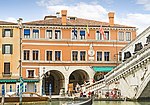Search results
Appearance
There is a page named "Magistrato alle acque" on Wikipedia
- The magistrato alle acque (lit. 'magistrate for the waters') was a collective magistracy of the Republic of Venice, responsible for water management in...9 KB (936 words) - 15:40, 6 May 2024
- regionally or locally. The major authority on the lower Po was the Magistrato alle Acque di Venezia, first formed in the 16th-century Republic of Venice...38 KB (4,457 words) - 04:53, 15 June 2024
- the task by the newly formed Italian Kingdom, thus replacing the Magistrato alle Acque in 1866 upon annexing the city. The Institute ceased to exercise...29 KB (3,342 words) - 14:47, 1 January 2024
- Servolo Santo Spirito Sottomarina Vignole List of islands of Italy Magistrato alle Acque MOSE Project This geological history follows Brambati et al. (2003)...17 KB (1,523 words) - 12:24, 30 June 2024
- his uncle, Matteo Lucchesi, who was a leading architect in the Magistrato alle Acque, the state organization responsible for engineering and restoring...21 KB (2,461 words) - 00:24, 26 June 2024
- tower was leaning by 7 centimetres (2.8 in). Beginning in 2007, the Magistrato alle Acque, responsible for public works, reinforced the foundation, adopting...79 KB (9,203 words) - 23:53, 1 June 2024
- latter in 1797. Until 2014 it housed the city's water officers (Magistrato alle Acque). The palace has a longer façade on the Ruga (alley) degli Osei...2 KB (268 words) - 17:43, 30 November 2023
- restoration of the monastery's structures was carried out by the Magistrato alle acque under the coordination of Consorzio Venezia Nuova, an agency of...100 KB (9,041 words) - 05:08, 22 April 2024
- exchanged some buildings on the Giudecca of the Magistrato alle Acque for the Palace of the Dieci savi alle decime in Rialto, which had served as a subsidiary...13 KB (1,713 words) - 17:38, 15 January 2024
- regulated the sale of meat, and the Magistrato alle Acque, which protected the Venetian Lagoon from pollution, the Magistrato alla Sanità also oversaw the trades...25 KB (3,257 words) - 01:14, 6 December 2023
- Lotto, Lorenzo Luogotenente Madrid, 1617 treaty of Magistrato alle Acque Magistrato alle Pompe Magistrato alla Sanità Malipiero, Pasquale Manin, Ludovico...20 KB (1,484 words) - 03:47, 2 February 2024
- di Biogeogeafia Adriatica 9: 33-66. Magistrato Alle Acque – Mizzan, Studio B.6.78/I. Attività di monitoraggio alle bocche diporto. Controllo delle comunità...28 KB (3,928 words) - 11:56, 3 June 2024
- for the exam for lawyer ) (Giuffrè, 2006) and "Guida al concorso per magistrato ordinario" (Guide to the competition for ordinary magistrate) (Cedam,...48 KB (7,070 words) - 00:13, 15 August 2023
- Giuseppe Conte (che vuole abolire l'euro)". "Chi è Paolo Maddalena, il magistrato candidato al Quirinale dagli ex grillini". 24 January 2022. ""Salviamo...154 KB (13,030 words) - 20:10, 13 May 2024












